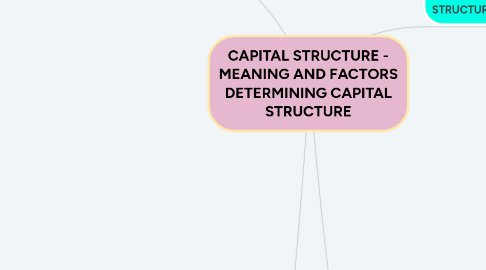
1. CAPITALIZATION IN FINANCE
1.1. WHAT IS CAPITALIZATION
1.1.1. Represents permanent investment in companies excluding long-term loans.
1.1.2. Types
1.1.2.1. Normal
1.1.2.2. Over
1.1.2.3. Under
1.2. OVERCAPITALIZATION: This situation arises when the company raises more capital than required
1.2.1. THE CAUSES CAN BE
1.2.1.1. 1. High Promotion cost
1.2.1.2. 2. Purchase of assets at higher prices
1.2.1.3. 3. A company´s floatation boom period
1.2.1.4. 4. Inadequate provision for depreciation
1.2.1.5. 5. Liberal dividen policy
1.2.1.6. 6. Over - estimation of earnings
1.2.2. EFFECTS
1.2.2.1. 1. On Shareholders
1.2.2.1.1. a. Profitability decreases, the rate of earning of shareholders also decreases.
1.2.2.1.2. b. The Market price of shares goes down because of low profitability
1.2.2.1.3. c. The profitability going down has an effect on the shareholders. Their earnings become uncertain
1.2.2.1.4. d. With the decline in goodwill of yhe company, share prices decline
1.2.2.2. 2. On Company
1.2.2.3. 3. On Public
1.3. UNDER CAPITALIZATION: Which incurs exceptionally high profits as compared to industry.
1.3.1. THE CAUSES CAN BE
1.3.1.1. 1. Low promotion costs
1.3.1.2. 2. Purchase of assets at deflated rates
1.3.1.3. 3. Conservative dividend policy
1.3.1.4. 4. Floatation of company in depression stage
1.3.1.5. 5. High efficiency of directors
1.3.1.6. 6. Adequate provision of depreciation
1.3.1.7. 7. Large secret reserves are maintained
1.3.2. EFFECT
1.3.2.1. 1. On Shareholders
1.3.2.2. 2. On Company
1.3.2.3. 3. On Society
2. VOCABULARY
2.1. KNOWN
2.1.1. FINANCIAL
2.1.2. CAPITAL
2.1.3. COMPANY
2.1.4. MARKET
2.1.5. INVESTORS
2.1.6. INFLATION
2.1.7. COST
2.1.8. DIVIDENDS
2.1.9. INSTITUTIONS
2.1.10. RESERVES
2.1.11. PROVISION
2.1.12. DEPRECIATION
2.1.13. SOLVENCY
2.1.14. GEARING
2.1.15. SALES
2.2. UNKNOWN
2.2.1. SHOULD
2.2.2. DEBENTURES
2.2.3. DURING
2.2.4. ISSUE
2.2.5. SHARES
2.2.6. SHAREHOLDERS
2.2.7. REGARDLESS
2.2.8. BORROWINGS
2.2.9. DISTINGUISHED
2.2.10. FOLLOWING
2.2.11. DRAFTING
2.2.12. PURCHASES
2.2.13. EQUITY
2.2.14. EMPLOYED
2.2.15. OVERESTIMATE
3. MEANING OF CAPITAL STRUCTURE
3.1. a. Type of securities to be issued are equity shares, preference shares and long term borrowings
3.2. b. Relative ratio of securities can be determined by process of capital gearing.
3.2.1. I. Highly geared companies
3.2.2. II. Low geared companies
